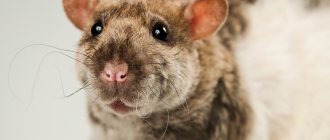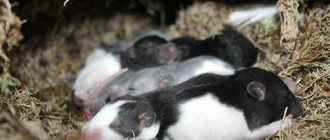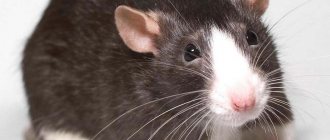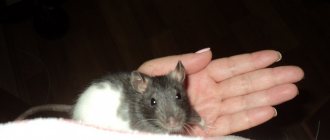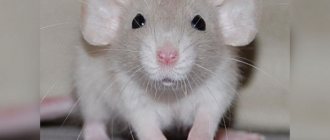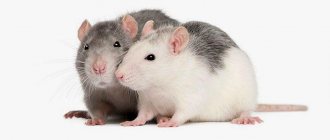Dumbos are pet rats with a cute face, large ears and a friendly disposition. Such pets are often owned by families with children. However, buying a rodent should not be taken lightly. First you need to learn about the features of its content.
Dumbo, unlike other rats, does not tolerate lack of communication well. If you don't pay enough attention to it, your pet may become wild or get sick.
Let's find out what this breed is and how to properly care for a cute animal so that it is healthy and cheerful.
Description
The Dumbo rat has a distinctive feature - large round ears, which give it a special charm. But she is loved by rat breeders not only for her interesting appearance - the namesake of the Disney baby elephant has other advantages. However, Dumbo cannot be called an ideal pet either, so before buying a rat, you need to find out about the peculiarities of its maintenance.
Beginners in rat breeding, first of all, need to understand one thing: all the names of decorative rats (Dumbo, Rex, Sphinx, etc.) indicate variations of the same breed - Rattus Norwegicus dom (decorative rat). One litter can contain pups of different variations.
Belonging to a particular variety is determined by the structure of the animal’s body, the characteristics of its appearance and the quality of its fur. Dumbo rats can have characteristics of other breeds and are called Dumbo Rex, Dumbo Sphinx or Dumbo Husky.
Dumbo has a pear-shaped body, the maximum size of which reaches 20 cm in length, with short, dense fur. The ears of these rats are located lower than those of their relatives.
What varieties are there?
As a result of selection, the following notable subspecies of Dumbo rats were obtained.
Rex
The body is covered with curly, dense hair. In young rats, the hairs stick out funny in different directions, as the curls are just forming. In some cases, even the mustache curls.
A healthy individual has no bald spots or bald spots on the body - the hair evenly covers the entire body. The skin is soft and plush to the touch.
Reference! Dumbo Rex is a subspecies that has not yet been included in the breed standards.
Sphinx
Just like cats of the same breed, Dumbo Sphinx rats are completely hairless. Their skin is soft, velvety, folded. The mustache may be short, curled, or absent altogether.
Due to their peculiarity, they often injure the skin and contract infectious and viral diseases. If you are planning to get two rats at the same time, then keep in mind that only their breed can be added to Sphynxes.
Other rats may be quite aggressive towards them, due to the specific appearance associated with the disease.
Siamese
The fur on the body is a delicate, light cream color, and the muzzle and paws are outlined in dark brown. The gene for this color is recessive, so it is passed on from generation to generation quite rarely. This explains the high price for baby rats.
Husky
Dumbo Husky rat pups are born in a completely standard color: brown, gray or black. Only with age do the snow-white hairs characteristic of this color begin to appear on the fur coat.
Manx
Breeders still treat this subspecies rather coldly and oppose the breeding of such individuals. The fact is that the absence of a tail in Dumbo-Monx is a consequence of a complex mutation. Taillessness for a rodent means a loss of balance and the inability to cool the body in moments of overheating.
Manx often have serious problems with the musculoskeletal system, due to which they rarely live to be a year old.
Blue
The Blue Dumbo has a light gray coat with a noticeable bluish tint. It is quite rare, which is why breeders often raise the price of rat pups.
Differences from wild rats
While ornamental rats are very similar to their wild relatives, there are significant differences between them. The most noticeable difference is the appearance. Random mutations (mostly in color) can occur in the wild, but are rare.
Decorative rats are calmer and less aggressive towards humans due to breeding and, as a result, the constant selection of producers with the desired set of behavioral qualities. However, ornamental rats, like any other domestic animals, can become wild and over several generations produced in natural conditions, their behavior and attitude towards humans can become indistinguishable from initially wild rats. This phenomenon is regularly encountered by rat lovers who are engaged in catching colonies or families of decorative rats that find themselves on the street.
Decorative rats have greater body weight and fertility. They are less afraid of new products, they have a calmer reaction to light and sound, and neophobia is less developed. Wild rats are mainly nocturnal, sometimes going out during the day in search of food. In domesticated rats this is not so pronounced. In a fight, wild rats produce sharper screams than domestic ones. In addition, a wild rat that loses a “battle” almost always runs away from the winning one, while domesticated rats can behave differently after a fight.
Domesticated rats live longer than wild ones. This is because kitty rats are protected from predators and always have access to food, water, shelter and veterinary care. Their average lifespan is approximately 2–3 years, unlike wild ones, which on average live less than 1 year. Wild rats have larger brains, hearts, livers, kidneys and adrenal glands. However, decorative rats, like wild ones, are susceptible to many different diseases, among which a special place is occupied by the respiratory syndrome of mouse-like rodents (respiratory diseases of various etiologies), as well as various neoplasms (tumors of the mammary glands, brain, etc.).
Colors
The color of animals of this breed variety, as well as the length and quality of the coat within the species, can vary greatly. Most often there are individuals with short, velvety, straight hair in gray, white, black and chocolate colors. Rare colors of dumbo rats are Siamese, amber, topaz, and mosaic (tricolor).
Amazingly beautiful Dumbo rat of blue mink color. You can find it only from large breeders at a price that is quite high for decorative rats.
Scientists, by crossing rodents of the Dambo breed variety with decorative rats of other breeds, managed to obtain new subspecies that deserve the attention of amateur rat breeders.
Dumbo rats have the following subspecies:
- Cat claw attachments
- Dog
- Long-eared cats
- Cat meowing
- Alexandrian parrot
- Why does a cat need a mustache?
- Sphynx - can be white, blue, chocolate and black. Their body is completely devoid of vegetation. There is some hair on the back, paws and head. There are either no mustaches at all, or they are very small and curled upward. Suitable for people with allergies;
- rex - on the contrary, has thick, wavy and fairly stiff hair;
- Husky is a chameleon rat. Only it has the amazing ability to “bloom” - to change color with age. Babies are born of a standard color - black, gray, red, etc., but with age, their fur is diluted with white hairs - so that, born black, a rat pup, having matured, turns into a snow-white miracle. Their ideal color is “salt and pepper.”
Rats are very similar to people - they can dive and swim, are subject to stress and psychological shocks, dream, are afraid of tickling and can laugh, albeit in the ultrasonic range.
Experienced rat breeders know how long domestic Dumbo rats live. And you won’t be able to please beginners with the length of your pet’s life – you need to immediately get used to the idea that your pet will stay with you for about 2-4 years. Thanks to good care and nutrition, many manage to extend their life by a year and a half, but no more.
Types of decorative rats
There are several varieties of the Dumbo breed:
Siamese
The color of the Siamese is similar to that of the cat breed of the same name: white or light beige fur and a small brown spot on the face.
Siamese
Husky
The color of the husky is similar to the color of the coat of the dog breed of the same name: white coat with dark spots on the body and head.
Husky
Rex
The Rex's long curly coat, hairs and whiskers are slightly curled.
Rex
Sphinx
There is no wool. The skin is thin, soft and warm. The main advantage of the species is its inability to cause allergies.
Sphinx
Description of character
Rats are intellectuals with a soul and are very attached to their owner. They need communication and attention, otherwise they will wither away. The character of domestic rats of the Dumbo breed is calmer and more reserved than the rest. They are not that active. Very sociable, freedom-loving and cheerful. Experts advise taking rat pups not from pet stores, but from breeders, when they are very young, then the pets grow up to be affectionate and trusting little animals. Dambiks are very clean. If their house is dirty, they take care of cleaning themselves.
What to name the animal
You shouldn't give your pet the first name that comes to mind.
It is advisable to choose names for your pet that will highlight its individuality. To choose the right one, you can rely on the recommendations of experienced rat breeders.
- There is no need to rush to give your Dumbo rat the first name you like. You need to take a closer look at the pet, observe it, and note its characteristic behavioral features.
- Each pet is special to its owner and has the right to a “special” name. Therefore, you should not stop at the usual names for rats, but choose an original one.
- If there are several animals, they can be given names from the same category. For example, the names of the planets are suitable.
- Hints in choosing a name can be found in fairy tales, cartoons or nursery rhymes.
It is important to choose a name that can be changed to a diminutive. This is what the owner will most often call his charming pet with big ears.
Dumbo the rat is one of the best pets. Communication with him is always interesting and evokes a lot of positive emotions. Taking care of a rodent is not difficult, and food costs are low.
Pros and Cons of Keeping Dumbo as a Pet
The decorative rat is one of those pets that does not require large expenses for its maintenance. Rats are curious and everyone wants to try their teeth. In addition, they require constant attention as they can fall and get hurt.
What attracts these animals is their developed intellectual abilities and lack of aggression towards humans and other animals.
The advantages of choosing Dumbo the rat as a pet include:
- cleanliness of the animal;
- omnivorous;
- low maintenance costs;
- ease of care.
But there are also disadvantages:
- the property of an animal to leave marks wherever it is;
- tendency to chew on any objects;
- expensive treatment;
- people with a keen sense of smell notice a specific smell that comes from domestic rats;
- for your pet to feel well, you need to devote a lot of time to it;
- walking is required;
- relatively short lifespan.
How long do dumbos live?
Under good living conditions, the average lifespan of a Dumbo rat is 3-3.5 years. However, premature death of the animal can occur as a result of certain diseases. Representatives of this breed are susceptible to the following diseases:
- conjunctivitis;
- mycoplasmosis;
- neoplasms;
- helminthiasis
To avoid adverse consequences for the health and life of your pet, it is important to know the main symptoms indicating malaise: decreased activity, runny eyes and nasal passages, refusal to eat and drink, fur sticking out in different directions, prolonged solitude in a house or in the corner of a cage.
Care and maintenance
This type of rodent was bred artificially, so it can only exist next to humans. And, naturally, it requires attention and knowledge on how to care for the rat Dumbo. The baby needs to immediately create suitable living conditions. The room where the little tenant will live should be bright and sunny. A cage for a decorative rodent should be placed at a height of 1-1.5 m from the floor, away from windows, radiators, stoves, and strong noise.
It should be made of metal rods (so as not to be chewed through like plastic ones) and with a deep tray. Size – quite large (minimum 40 x 30 x 50 cm). It is not recommended to use an aquarium for these purposes - it will be difficult to restore order there, plus there is no necessary ventilation. A mandatory accessory of the cage is the “house”. The pet will rest there. And all kinds of stairs and tunnels intended for entertainment are desirable, but not required. A ball drinker (not a bowl) and a fixed feeder are also necessary.
It is better to use corn, pressed sawdust (not very large in size), and paper as filler. Do not use cat litter, newspapers, or pine sawdust. You need to do “general cleaning” in the cage once a week, or more often. And the water needs to be changed every day. The temperature in the room where everyone's favorite lives should not exceed 30 degrees, but also not fall below 20 °C.
A cage for a decorative rat should not be in a draft or in direct sunlight - this has a detrimental effect on rodents.
Where does the Dumbo rat live?
Photo: Dumbo domestic rat
The wild predecessor of the cute “dambiks” inhabits mainly Asian and South American jungles, like all other breeds of rats, occupying almost all available niches. But the tame rat Dumbo, to which this article is dedicated, is much more demanding regarding the conditions of its maintenance. But all the costs and efforts of the owner are paid off a hundredfold by the boundless trust and tender affection expressed to him by the furry animal.
Regarding ensuring proper conditions of detention, there are several options, each with its own advantages and disadvantages. It is best to use an ordinary cage as a home for Dumbo rats - believe me, there will be plenty of living space in it. You can buy a dambiku wire cage at a pet store. The optimal dimensions are 60x40x60 cm with a maximum distance between the bars of 1-1.2 cm. A cage for a dumbo rat must have a solid bottom, a high tray (only made of plastic, wood and metal are not suitable), as well as wide doors and shelves.
To eliminate the specific rat odor, it makes sense to purchase corn or wood filler. Some owners use napkins, toilet paper and sawdust instead. If you can still agree with the last option, then the first two are completely unsuitable. The furry rodent's cage is equipped with hanging metal bowls intended for dry food. In addition, you cannot do without a special nipple drinker. Various treats and liquid food are best placed in small ceramic bowls.
To ensure maximum comfort for a little rat, it makes sense to place a house inside the cage. Dambiks love to hide and sleep in it. A cozy, warm hammock will be a favorite accessory for decorative rats - but this is where the adults will spend their “leisure.” Stairs, tunnels and ropes will also be used by rats for their runs.
Feeding
These pets are quite unpretentious in their choice of food, but are not omnivorous, like ordinary ones. Decorative rats are very gentle creatures, often having problems with the intestines and allergies.
Its menu should include:
- grain base - it is better to purchase a special mixture for rodents in pet stores. It should make up 60% of the total diet. You can also feed with unprocessed pumpkin, flax or sunflower seeds;
- proteins - occasionally (1-2 times a week) give a little meat (raw or boiled), chicken, yogurt, cottage cheese, eggs will benefit your pet;
- herbs - parsley, cilantro, dandelion, dill, plantain, radish tops;
- vegetables and fruits (preferably boiled) - apples, bananas, carrots, white cabbage, cucumbers, tomatoes, pumpkin, eggplant, potatoes. Citrus fruits must be treated selectively - they can cause allergies in your pet;
- delicacies - grain sticks, nuts, dates, berries, dried fruits, raisins, crackers (unsalted only), unsweetened cookies, boiled pasta, boiled shrimp and seafood.
It is necessary to give fish oil and specialized vitamins. Animals are fed 2 times a day: morning and evening. The exception is pregnant rats - they are fed 4-5 times a day. If you adhere to the basic requirements for what to feed your rat Dumbo, he will be healthy and cheerful.
If your pet refuses to eat for 1-2 days, you should immediately show him to a veterinarian!
Prohibited Products
If the owner is interested in his pet living as long and healthy as possible, the following products should be avoided:
- chocolate and products containing it;
- other sweets;
- sausage and frankfurters;
- canned food for people;
- raw beans and other legumes;
- cheeses (especially blue and salted);
- soda;
- sprouted potatoes;
- Brussels sprouts and red cabbage;
- green bananas;
- spinach;
- beet;
- fatty and salty foods.
Knowledge of what can and cannot be given to decorative rats will help you correctly formulate the rodent’s menu and avoid unnecessary worries and health problems.
Lifespan
The average lifespan of sphinxes is 2-2.5 years. This is slightly less than the age of rats of other breeds. Premature death is explained by the predisposition of hairless rodents to a variety of diseases, for example:
- renal and liver failure;
- neoplasms;
- diabetes;
- pathologies of the heart and blood vessels;
- stroke;
- allergic reactions;
- cystitis.
In addition, due to the lack of fur, Sphynx cats are prone to developing colds. Additional problems are caused by exposure to direct sunlight. Under the sun, the rat becomes very overheated, even to the point of heatstroke. And on delicate skin, symptoms of dermatitis appear or burns form.
It is worth noting that despite all the health problems, if the animal is provided with proper care and periodic preventive examinations by a veterinarian, the life expectancy of a hairless rat can be more than 3 years.
Bathing rats
Perhaps, rats can be divided into two “camps” - some are wary of bathing, and you will have serious problems when trying to bathe your pet, while others will happily climb up to perform bathing procedures.
Rats are very clean and you shouldn’t have a need for a “routine” bathing as such, and you shouldn’t bathe rats unnecessarily .
However, there are times when bathing is necessary:
- The rat got very dirty with something that it absolutely cannot eat (while walking around the house, rats can accidentally knock over something).
- The rat emits an unpleasant odor and has an unkempt fur or tail (if you have not had the opportunity to change the cage substrate for a long time, for example, or if the rat does not take care of itself);
- If you need to detect and remove parasites;
- Older rats need to be bathed as they find it difficult to groom themselves.
Breeding
Female Sphynx cats go into heat weekly. When kept at home, rats actively breed. If one of a pair of animals is sick, it is better to postpone breeding until it is cured and isolate the animal from its partner.
After the birth of the cubs, the owner should not take the babies in his arms. This necessity is dictated by the tendency of rodents to eat their offspring in the presence of foreign odors. After a month from birth, young rats are placed in separate housing.
Given their fragile health, the reproduction of these pets must be taken seriously. If offspring are not planned, they can be sterilized at a veterinary clinic.
The hairless variety of rats was originally bred for laboratory experiments, but accidentally escaped the scope of scientific experiments. Touching and funny animals have a huge advantage over other decorative pets - they are able to understand and subtly feel people.
With proper care and regular communication, sphinxes become kind and devoted friends and give their owners many bright emotions.
How to bathe a pet rat?
There are some rules that you need to know in order to buy a rat correctly, but each owner will figure out the nuances himself. During the first baths, it would be useful to have a second person present as additional insurance in case the animal gets scared.
- The room must be securely fenced off from drafts - rats catch colds quite easily.
- The water should be warm, but not hot.
- It is necessary to bathe the rat in a container with a small amount of water, especially if it is afraid to bathe. Ideally, the rat can stand in the water.
To wash, use a special shampoo for rats - this will not cause an allergic reaction and will make your pet’s fur smooth and shiny, and the special shampoo is easier to wash off.
Be sure to read the instructions - some shampoos require first diluting with water.
Be careful not to get the shampoo in the rat's eyes. Also, during bathing, it is necessary to ensure that water does not get into the animal’s ears; this is fraught with complications, including deafness.
Rats' skin is very delicate; for heavily soiled areas, you can use a very soft sponge, but it is preferable to use your hands. Massage the rat's fur as carefully as possible so as not to touch it with your nails.
After bathing, carefully dry the rat with a towel and then leave it to dry, preferably wrapped in another dry towel.
If you have several pets, the first time after returning from swimming, carefully monitor their behavior - when bathing rats, their natural smell is “washed away”, and relatives may not recognize their companion at first.
Remember that bathing rats is unacceptable if they have wounds or scratches on their bodies, or if the rat is sneezing or showing other signs of illness.
If only the tail or paws, for example, or a small area of fur are dirty, you can get by with “local” cleaning instead of a full bath.
Pet health
Caring for and maintaining a Dumbo rat involves caring for the health of the animal. Representatives of the Dumbo breed are prone to respiratory diseases. They also have tumors and abscesses. Often, long-eared rats develop conjunctivitis. If alarming symptoms are detected, it is necessary to take your pet to a veterinarian as soon as possible.
Signs of illness in Dumbo rats are:
- greasy, unkempt wool;
- lethargy, apathy;
- loss of appetite;
- redness of the eyes, tearing;
- nasal discharge;
- hard breath;
- the appearance of bald spots and scratches on the skin;
- bumps on the body.
The owner must follow the veterinarian's recommendations. The cage is moved to a warm place and try not to disturb the animal. It is important to make sure your rat drinks water. Otherwise, you will have to unsolder it from a pipette or syringe without a needle.
Important! If a pet is diagnosed with an infectious disease, then it must be isolated from other rats and placed in another cage.
Diseases and treatment
It’s hard not to notice if your pet is unwell. A healthy rat has shiny fur, clear and clean eyes, and the animal is playful and active. If deviations in health status are observed, you should immediately contact a veterinarian.
The most common diseases of decorative rats:
- Mycoplasmosis . Infection occurs through airborne droplets and progresses to pneumonia. Deadly dangerous.
- Abscesses . Associated with injury to the animal. An opening and disinfection of the inflammation site is required.
- Development of benign and malignant tumors.
- Parasitic lesions. Rats are not dewormed. Treatment is carried out only if the disease is detected.
Advantages and disadvantages of the breed
The absence of hair is an undeniable advantage for people prone to allergies to pet hair. An elegant, thin body combined with pink transparent skin, sparkling eyes and large ears give the rodent an unusual, extravagant appearance that attracts exotic lovers.
The lack of fur is associated with various disorders in the functioning of the body, which were fixed by scientists at the genetic level, so hairless rats are more susceptible to allergies and diseases of the skin, eyes, heart and kidneys, oncology and diabetes than their furry relatives.
Vaccination
Decorative rats do not need vaccination. No drugs have been developed for them to help prevent the development of diseases in these animals.
Selection and accessories for your pet
An animal's cell must contain several elements:
- drinking bowl;
- feeder;
- nest (place to sleep);
- a mineral stone on which the animal will grind its teeth.
To prevent the animal from getting bored, toys are placed in the house. Rats are very fond of such a device as a hammock. It can be made from a piece of durable fabric or purchased ready-made at a pet store.
Most preferred toys:
- ladders, including rope ones;
- tunnels;
- labyrinths.
Housing
When choosing a cage, you need to remember that it should be comfortable and spacious. It is better to give preference to multi-tiered cells. Also remember that items made from plastic and wood are not suitable as rodents will destroy such items in a short time. The cage must be metal, the length must be at least 60 cm, and the width must be at least 50 cm.
In addition to the size of the cage, attention must be paid to other parameters, namely, the distance between the rods should be no more than 20 mm. The tray should be high, the floor should be level, and the door should be wide. A house and a hammock must be installed in the cage. The house is installed so that the animal can hide when it is scared, or is tired of attention, wants to sleep or just relax.
Be sure to arrange an area for eating, in which bowls and a drinking bowl are installed. You will need several bowls, since you cannot mix natural products and feed.
It is better to purchase a special drinking bowl that is fixed on the cage, so the water will stay clean longer and will not spill. Remember that the cage is regularly cleaned and washed, and be sure to wash all accessories.
Regarding entertainment and games in the cage, they must be present. When a person is busy, the animal must entertain itself independently. Specialized stores offer a fairly wide range of all kinds of entertainment accessories.
You can purchase ropes, tunnels, ladders. Many owners make toys themselves. An important element in the cage is a special mineral stone, which helps the rodent to properly grind down its teeth and claws.
Regarding aquariums that are offered to be purchased instead of cages, this housing is not suitable for rodents, and experienced breeders categorically do not recommend them; they note the following disadvantages:
- Due to the blank walls, there is very poor ventilation in the middle.
- Fecal gases and an unpleasant odor accumulate inside.
- The cleaning and cleaning procedure is quite difficult.
- Regular disinfection is necessary.
Reproduction
How to determine gender?
Males can be distinguished from females by their enlarged testicles, which are clearly visible already at the age of 2–3 weeks. In female decorative rats, the rudiments of nipples are observed during this period of life.
Mating
Sexual maturity occurs early - at the age of 5–6 weeks. But individuals from 8 to 10 weeks are recommended for mating. In order to get offspring, it is enough to leave the male and female in the same cage for a couple of days. But you need to understand that fertilization is possible only if the female is in heat. It occurs regularly at intervals of 4–7 days.
Pregnancy
From the moment of fertilization to the birth of rat pups, no more than 23 days pass. On average, birth occurs between 21 and 23 days. The female's pregnancy becomes noticeable starting from the second week after fertilization. The animal’s physique plays a big role in the appearance of the first signs. If the female is thin, the rounded tummy will be noticeable faster than in a fat and large rat.
A litter can contain from 8 to 15 pups. During pregnancy, the female needs increased and nutritious nutrition. Bloody discharge and the female's desire for privacy will indicate the approaching birth . Often the dumbo rat begins to prepare its nest: it cleans and arranges it. Childbirth lasts no more than 3 hours.
How to care for newborn rat pups
The female Dumbo takes good care of her offspring.
During this period, the owner must follow several rules:
- do not pick up baby rats;
- take care of the cleanliness of the cell;
- provide the mother with good nutrition.
Rats can be handled once they are 14–15 days old.
How to determine gender
The sex of adults can be determined quite easily. To do this, you just need to carefully study the structure of their genitals.
Things are more complicated with baby rats. Their gender can be determined with certainty only a few days after birth.
To determine the gender of a small rodent, you need to pay attention to its tummy, which is still completely devoid of fur. If we can see two rows of nipples, which during this period resemble small pimples, we have a girl; if not, we have a boy.
If you want to keep several rats, but are not going to breed them, choose girls. It will be easier for females to get along together than for males, who will periodically engage in fights for leadership, territory and food.
Choosing a name for Dumbo the rat?
The owners are trying to give the young, smart baby Dumbo a deep and meaningful nickname in the hope that the animal's name can influence the character and intelligence of the funny animal. Sometimes it can be difficult to immediately name a pet with a suitable name that emphasizes its individuality and expresses the love of its owner.
It is advisable to take a few days to take a closer look at the habits and character traits of the new family member; most likely, he himself will tell the owner what to call him. The furry baby's nickname can be tied to the color of the rodent's coat and funny ears, human associations from the pet's appearance and funny faces, favorite book and cartoon characters or pop stars. The rodent's nickname should be simple and easy to pronounce in a diminutive form. It is believed that females respond better to nicknames that begin with the letters K, M and D. Males are more fond of names with the letters S, K, M and D, long-eared pets are more willing to get used to nicknames with the letters T, N, L, M, K , S, Sh and R.
The name for a Dumbo rat girl can be: Knopa, Scully, Masya, Dana, Molly, Ksyusha, Marta, Alice, Dasha, Klava, Matilda, Gina, Darcy, Alpha, Kayla, Linda.
The name for a dumbo boy rat can be: Kuzya, Tyson, Tim, Rocky, Simson, Garik, Steve, Venya, Bucks, Rocky, Dick.
It doesn’t matter what the owner calls the smart-eared baby. In any case, the baby rat Dumbo will sincerely adore and faithfully wait for his beloved owner, giving him his incredible tenderness and selfless love.
Video
Training and playing with your pet
Dumbo is very trainable
Dumbo rats are quite obedient and easy to train . They love to play with soft and hard balls, willingly explore labyrinths and run through their owner's hands. Many pets love to climb onto the shoulders and watch everything that happens from there.
If you want to teach a rat various tricks, you need to remember a few rules for training these rodents:
- The optimal duration of classes is 20–30 minutes.
- The animal is fed for the last time 8–10 hours before class. In this case, he will be more willing to do what the owner requires, wanting to receive food for it.
- It is necessary to ensure that the animal fully understands what is required of it. Only after this do they move on to learning other tricks.
What can you teach a Dumbo rat:
- find one object out of several;
- remove pieces of paper and beads hidden in a matchbox;
- stand on its hind legs at the owner's command.
Main differences between the species
Rats are classified into separate breeds based on the presence of certain criteria characteristic only for a particular species. The main distinguishing features are:
- Body type. The classic option is considered standard. Representatives of this species are distinguished by their average body size - up to 25 cm from the tip of the nose to the tip of the tail, rounded, high-set ears, and large eyes. In general, pets look proportional and graceful. Boys are larger than girls. The next type is dumbo. The main distinguishing feature is small round ears set on the sides of the head. Pointed ears are also considered a variant of the norm, but only slightly. Another body type is tailless. The name speaks for itself; the animals do not have a tail.
- Coat type. Standard – medium-length shiny coat evenly covering the body. Only the toes and tail are covered with barely noticeable fluff. Curly – pets are distinguished by curled mustaches and a curly coat, slightly straighter on the stomach. Wavy – thick coat with developed undercoat. The fur of both sexes is soft to the touch. Vibrises are distinguished by barely curled tips. Downy – the rat’s body is evenly covered with dense short fluff, reminiscent of corduroy to the touch. The fur on the face may be slightly longer. The Sphynx has no fur at all. A minimum amount of hair is allowed on the muzzle and in the groin area. Long-haired - the animal is covered with thick, long hairs that are soft to the touch.
- Color. Among decorative rats you can find a pet of a wide variety of colors - plain, targeted, combined, silver, even tricolor.
Different breeds of rats differ not only in appearance, but also in character and temperament. Some breeds lead a sedate lifestyle. Others, on the contrary, prefer active recreation.
The largest and smallest species of rats on the planet
There are real giants among these rodents in the world. In China, bamboo rats live, which reach 4 kg in weight and grow up to half a meter.
And in Africa you can find a reed rat, the size of an adult individual of which is 61 cm. Such a miracle weighs almost 9 kg. In captivity, it can only be kept under conditions artificially created for it.
The smallest species live in New Guinea, the Pacific Islands and Central Asia. They are called Pacific. The body of the animal ranges from 11 to 15 cm, and the weight of an adult rat is no more than 80g.


